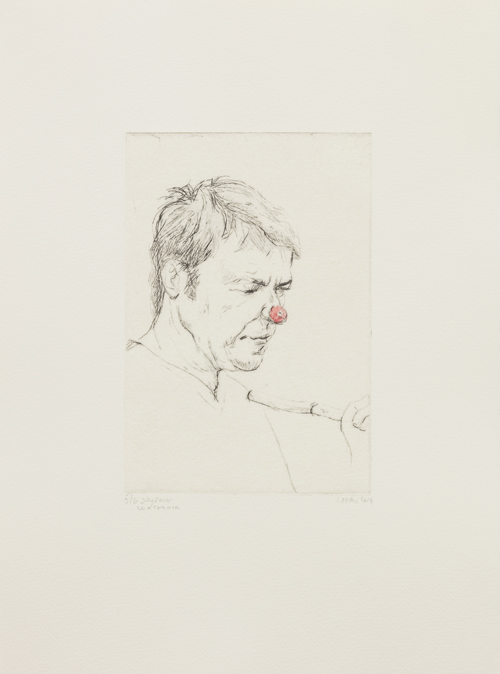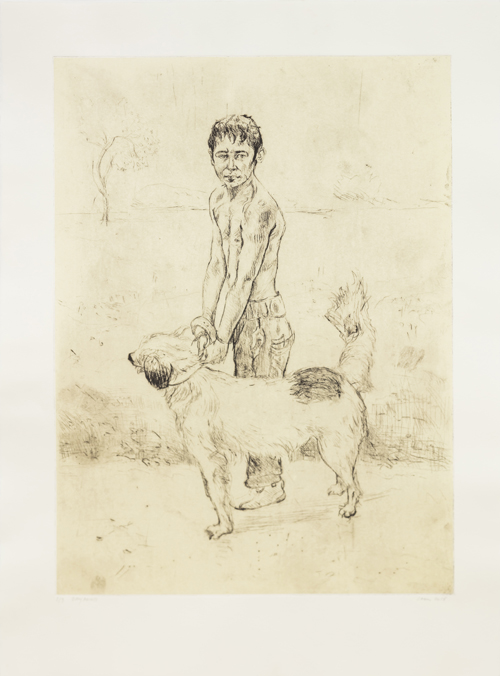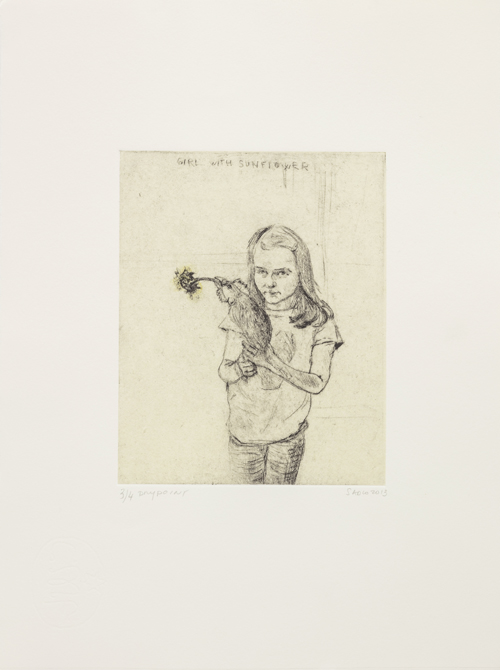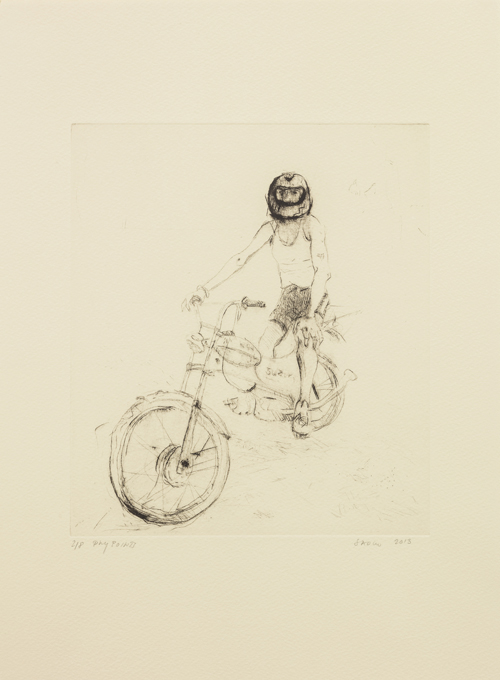Centre of Gravity
Sadko Hadžihasanović
a survey of drypoints
January 8 - February 13, 2016
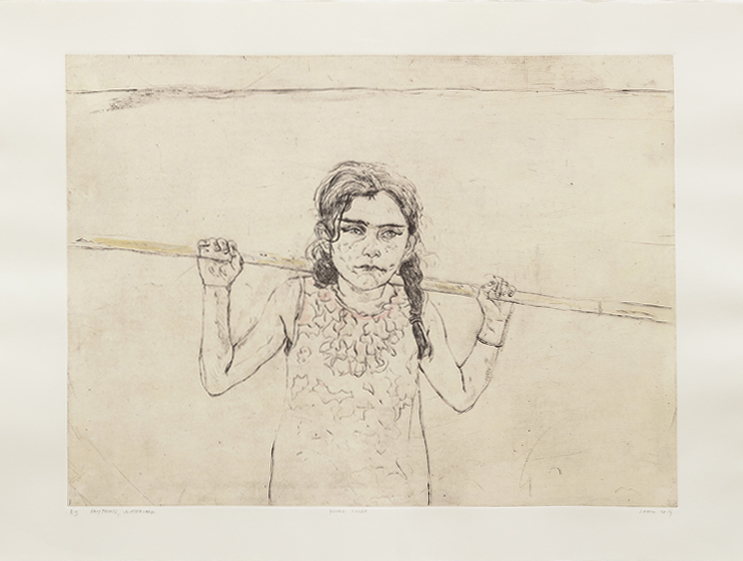
As an artist and art educator Sadko has always been a strong proponent of drawing before painting. Such has been the case in the practice of Stephen Andrews, or in the relationship between Lucien Freud's etchings and paintings.
As a viewer one can nearly always make out Sadko's drawn element under the paint, under the collage or mixed media. Drawing is rarely on its own, unattended. A survey of Sadko's drypoints enables the viewer to focus exclusively on the technique of drawing and the drawn subject.
Two years ago, after several years of producing monotypes, Sadko wanted a change and a new printmaking challenge. Drypoint held a natural allure because it is a linear medium and drawing is essential. While rapidly embracing the freshness and immediacy of drawing on the etching plate, similar to pencil drawings yet different, a new dimension opened up as the printed works evolved.
Sadko comments on the "beautiful delicacy of lines sitting on the printed paper. They would range from very tiny, almost hair-like, lines to expressive, blurry and dark lines." Sadko also observes that the subjects are always from elsewhere, during various travels. This can partly be explained by his use of the photograph as a source material for the work. Beyond that, the speculation of the motivations behind choices may be seen as a byproduct of cultural relocation (Sadko and his wife immigrated to Canada in 1993 during the war in Sarajevo), finding the centre of gravity for his subjects in their countries and economies, and finding a new centre of gravity in a country (Canada) that has now become his home.
The artist would like to thank master printers Allen Ash, Calvin Chumbley and Tim Laurin.
Sadko Hadzihasanovic studied at the Academy of Fine Arts in Sarajevo, Bosnia, earned his MFA at the University of Belgrade, Yugoslavia (1984) and arrived in Canada in 1993. Since his arrival from Bosnia, Sadko has participated in over eighty exhibitions in public galleries and artist-run centres across Canada and in the former Yugoslavia and maintains several teaching positions in Toronto, Barrie and Guelph, Ontario. He is the recipient of visual arts grants from Toronto Art Council, the Ontario Arts Council and the Canada Council for the Arts. Sadko continues to explore identity, and its cultural and social implications, with an extensive portraiture-based body of work using mixed media and collage, and an array of references to popular culture.
Essence and Being: Musing on the Art of Printmaking and the Drypoint Prints of Sadko Hadzihasanovic
(quoted from a larger text by Ted Fullerton)
Sadko Hadzihasanovic’s interest in the medium of printmaking is founded in “knowing” its essence is rooted in the spirit of drawing – and the essence of its materiality and process associating with an unconscious suggestion of “being.” Within his most recent work in printmaking, Sadko is driven by the desire to realize his work in drypoint, which is profoundly associated through the direct physicality of process and materials to the images he creates.
Within the small edition of prints drypoint can realize, a result of bur on plate against the intensity of the imposed pressure within the printing process, this vulnerable “nature” and the dramatis personae of the wiped inked plate offers a uniqueness of “attitude” to each performance, making a distinctive statement within a consistent “reality.”
Sadko’s previous work in painting, drawing and printmaking on commercially printed wallpaper brings into line the notion of Western associations of achievement and success, underpinning the image's narrative. This is evident by looking at his earlier work where he uses this idiom as a visual “ground” along with the use of popular mass media images that speak to “sameness” and copy, aligning a Western sensibility to familiarity and wakefulness.
However, it is the intaglio process of drypoint that “makes it mark” with a profound relevance of image that associates with the disenfranchised and marginalized individual(s) in his most recent work of the Roma, the Romanian people, a culture defined as outcasts and “gypsies”. In the drypoint, Punk on the Beach, the image is profoundly felt with the method of its realization. Drypoint is an intaglio process where the physical pressure of the hand – through the etching scriber – defines the intensity of line and form. In the case of how it is applied in Punk on the Beach, the resistance of metal – to the direct drawn line scribed into it – acts as metaphor to the young man and the “subculture” associated with resistance and opposition. Its very nature challenges the viewer not only with image as it sits outside the cliché of place and “person,” but the somatic presence of its “materiality.” And this is the interesting and riveting aspect of why Sadko’s images resonate with such vibrancy in drypoint.
If you consider his most recent work of the Roma, it is not difficult to appreciate how the medium of drypoint with its immediate, direct and honest engagement embraces its defined image. As Sadko indicates in an artist statement from an exhibition in 2014 at Paul Petro, he describes his encounters with his subject: “What was most striking was how naturally they stood in front of me, without reservations, without hiding their emotions. They did not pretend to be someone else. There was something spontaneous in their stance and in their expressions.” What is interesting in this statement is he could have substituted the methodology of drypoint as a means and an association, – a metaphor if you will – to the “essence” and exchange of what he is trying to capture, reciprocity with subject, materials and process.
In the drypoint, Pieta, the two children who appear to be brother and sister confidently engage with affectionate fun and a trusting belief in each other. The image is not maudlin, but rich with the essence of human promise. This sentiment is fixed within the evidence of process; the intimacy of touch in how the ink was realized to plate and the embossed image with paper reinforcing an intimate bond of wholeness. Self portraits speak to the gaze turned inward. In the drypoint, Self as Clown, Sadko exposes himself as the “outsider,” otherness is assumed and internalized as we consider our own sense of vulnerability and susceptibility. The drawn image is refined in its ability to capture “likeness” yet its scratched reality bears witness to human defenselessness and self-doubt. The engagement with process sanctions a significant condition of “being,” allowing the experience, and thus the work of art to relate to something beyond its physical form.
The repetitive pattern of process is printmaking’s essence or nature. The repeat is a poetic device that ensures an emphasis, not only within language and the body, but it also resonates at a psychological level sanctioning reassurance. Our physiology utilizes the repeat in muscle memory that can and does evolve into daily ritual. This rhetorical process reinforces “the statement” as well as the activity rather than to elicit information. It is a fundamental exercise that mimics life’s melody reinforcing the supporting character of pattern. Repetition always precedes pattern and it is within this sequence of reoccurring events that allows an archetypal essence to be experienced through the process of printmaking by the artist.
Carl Jung, the noted psychologist, has pointed out that within pattern lie the four functions of consciousness; sensation, thought, feeling, and intuition which equip humans to deal with the impressions of the world from within and without. For the artist/printmaker it becomes a sublime illumination of the world within and a development of the self, a “coming home” if you will, the subject of any great epic. It is an enterprise made up of lyric components. Reason and feeling take precedent during process, and although the distance of creative experience between artist and public still remains, personal insight coupled with intuition will allow the individual engaging with the work to experience a development of self that is unique and individualized. Illumination and distinctiveness through subjective reason are possible by essentially submitting to the mystery that presents itself. Within Sadko’s most recent drypoints he hints at the notion of the quintessence of who we are. Identity or “where is home” plays a persistent role within his work. The idea of “sameness” – as it exists within the multiple – resonates within a contemporary context as a detractor without considering that, like life, the original print is unique within the context of the many.
Ted Fullerton
Artist






